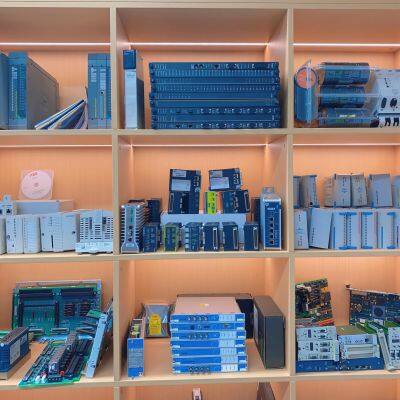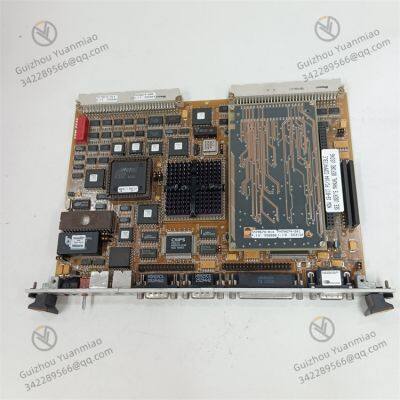Product Description
In the field of industrial automation and complex control systems, the XYCOM XVME-674 VMEbus PC/AT Processor Module occupies a pivotal position due to its outstanding performance. It is specifically designed to meet the demands for efficient data processing, stable operation, and flexible configuration in harsh industrial environments.
I. Processor Performance
The XYCOM XVME-674 offers users two processor options:
The 33MHz 80486 DX processor delivers stable and efficient computing capabilities for handling regular industrial tasks. It is well-suited for industrial automation processes that do not require extremely high real-time performance but involve moderate data processing volumes—such as equipment control on some light industry production lines and small-scale energy monitoring systems.
The more powerful 66MHz 80486DX2 CPU, with its higher clock frequency, enables rapid processing of complex algorithms and large datasets. In application scenarios with stringent requirements for computing speed and real-time response (e.g., automated scheduling systems in large transportation hubs, motion control for precision machining equipment in high-end manufacturing), the 66MHz 80486DX2 CPU ensures the system quickly processes various instructions and data, guaranteeing efficient operation of the entire system.
These two processor options provide adaptive processing performance for industrial applications of different scales and complexities.

II. Memory Configuration
In terms of memory, the XVME-674 features high flexibility, supporting 4MB, 16MB, or 32MB of DRAM:
For simple data acquisition and basic control applications, 4MB of memory is sufficient to store the small amount of data generated during operation and related control programs, ensuring smooth system performance.
In scenarios that require processing large volumes of historical data, complex graphic information, or running sophisticated industrial software (e.g., long-term production data recording and analysis in large energy enterprises, operation of product design and simulation software in manufacturing companies), 16MB or even 32MB of memory prevents system lag or data loss caused by insufficient memory—thus safeguarding the stability and efficiency of the entire industrial application.
Users can easily select the appropriate memory capacity based on the scale and complexity of data processing in practical applications, optimizing the module’s performance.
III. Interface Types1. Serial and Parallel Ports
The module is equipped with two serial ports and one parallel port:
Serial ports are used to connect various serial devices (e.g., industrial on-site sensors and intelligent meters), which transmit collected data to the XVME-674 module for processing via serial communication protocols. For example, in industrial automated production lines, many sensors that monitor parameters like temperature, pressure, and flow typically use serial communication. The two serial ports can simultaneously connect multiple types of sensors, enabling efficient data acquisition.
Parallel ports are mainly used to connect devices such as printers, facilitating the printing and output of critical production data and reports for staff to review and archive. In factory workshops, staff can connect a printer via the parallel port to print production data reports at any time, providing intuitive data support for production management.
2. Hard Disk, Floppy Disk Controllers, and VGA Graphics Controller
The XVME-674 integrates hard disk and floppy disk controllers, allowing direct connection to hard disks and floppy disks for storing large quantities of program files and historical data:
In industrial applications with high requirements for data storage security (e.g., transaction data recording in the financial industry, patient data storage in medical equipment), large-capacity hard disks can be connected via the hard disk controller to ensure long-term and reliable data storage.
The floppy disk controller supports scenarios that require traditional floppy disks for data exchange or program backup.
In addition, the integrated VGA graphics controller enables the module to directly connect to a display for graphic display functions. In industrial control interface presentation and visual monitoring of equipment operating status, the VGA graphics controller presents system data to operators through an intuitive graphical interface—helping them real-time grasp system operation and make timely decisions. For instance, in the central control room of a large factory, operators can real-time view operating parameters and equipment status of various production links via a display connected to the XVME-674, ensuring smooth production processes.

IV. VMEbus Features
The XVME-674 includes a VMEbus interruptor circuit with a powerful local interrupt generator function. The local CPU can generate VMEbus interrupts at any of the seven VMEbus interrupt levels.
In industrial control systems with multitasking parallel processing, different tasks or devices may generate interrupt requests at different times. For example, in an automated production line with multiple motors, sensors, and actuators, an interrupt request needs to be sent to the system when a motor malfunctions, a sensor detects abnormal data, or an actuator completes a specific action. At this point, the local CPU of the XVME-674 can generate an interrupt at the corresponding VMEbus interrupt level based on the urgency of these requests, allowing the system to quickly respond and process them.
This efficient interrupt management mechanism ensures the system promptly handles various emergency events, improves the real-time performance and reliability of the entire industrial control system, and prevents production accidents or system failures caused by delayed task processing.
V. Electrical Characteristics1. Operating Voltage and Output Frequency
The module’s operating voltage is 220V—a common industrial voltage standard that allows easy integration into most industrial power supply systems. Whether in factory workshops, energy stations, or power networks of transportation facilities, the XVME-674 can stably obtain power support.
Its output frequency is 30kHz. This frequency setting ensures high-speed transmission and reception of signals during data transfer, guaranteeing efficient and stable data transmission. In industrial data communication scenarios (e.g., real-time upload of large volumes of production data, rapid delivery of control instructions), the 30kHz output frequency effectively reduces data transmission latency and ensures the system’s real-time response performance.
2. Certification Standards
The XVME-674 complies with internationally recognized certification standards such as CE and UL:
CE certification indicates the module meets European standards for safety, health, and environmental protection, satisfying strict European market requirements for electromagnetic compatibility (EMC) and electrical safety.
UL certification focuses on product safety; passing UL certification means the XVME-674 meets safety standards established by Underwriters Laboratories (UL) in terms of design, materials, and manufacturing processes.
These certifications fully demonstrate the module’s ability to operate stably in diverse industrial environments—whether facing complex electromagnetic interference or strict electrical safety requirements—providing users with reliable performance guarantees and enabling its wide application in the global industrial market.

VI. Mechanical Characteristics
The module has dimensions of 163×38×58mm. Its compact size offers significant advantages for installation in space-constrained industrial control cabinets and equipment enclosures. For example, in some compact industrial automation equipment where internal space imposes strict size limits on modules, the XVME-674 can be easily integrated.
Additionally, its lightweight design not only facilitates installation (reducing physical labor and operational difficulty for installers) but also avoids adding excessive load to the overall equipment when the equipment requires frequent movement or structural adjustments. In industrial scenarios involving mobile operations (e.g., mobile loading/unloading equipment in ports, automated construction equipment on construction sites), the module’s lightweight feature enhances equipment flexibility and improves work efficiency.
In summary, the mechanical characteristics of the XVME-674 enable excellent adaptability in various industrial installation environments.
VII. Compatibility
The XVME-674 strictly adheres to the VMEbus standard, enabling seamless integration with numerous other VMEbus-compliant modules. When building complex industrial control systems, users can combine the XVME-674 with VMEbus modules of different functions (e.g., data acquisition modules, communication modules, power modules) based on actual needs.
For instance, in a large-scale chemical production process control system, the XVME-674 can serve as the core processor module, connecting to multiple data acquisition modules to collect various production parameters and interacting with remote monitoring centers via communication modules. This high compatibility provides great convenience for users—eliminating concerns about mismatched communication protocols or incompatible interfaces between different modules—and enables rapid construction of powerful, stable, and reliable industrial control systems to meet diverse system integration needs across industries and application scenarios.
VIII. Application Fields1. Manufacturing Industry
In automated production lines of the manufacturing industry, every link—from raw material processing to finished product assembly—requires precise control and efficient data processing. The XVME-674 can be used to control various equipment on production lines, such as motion control for machine tools and execution of robot operation instructions. With its powerful processor performance and rich interfaces, it can real-time collect equipment operation data and precisely control equipment according to preset programs—ensuring product machining accuracy and production efficiency.
For example, in an automobile manufacturing plant, the XVME-674 can control the tool movement trajectory of automotive component machining tools to ensure component machining accuracy, while coordinating robots to complete component handling and assembly—improving the automation level of the entire production line.
2. Energy Industry
The energy industry involves extensive data monitoring and analysis, as well as remote control of production equipment. During oil and natural gas extraction, it is necessary to real-time monitor wellhead parameters (e.g., pressure, temperature, flow) and remotely regulate extraction equipment based on this data. The XVME-674 can connect to various sensors via its serial ports, analyze the collected data, transmit the data to remote monitoring centers via communication modules, and receive control instructions from the centers to precisely regulate extraction equipment.
In power systems, the module can be used for monitoring and protection of substation equipment—real-time monitoring and analyzing power parameters, and quickly responding to abnormal situations to ensure stable operation of power systems.

3. Transportation Industry
In the transportation field, both the operation management of transportation hubs and the control systems of transportation vehicles have high requirements for equipment reliability and real-time performance:
In transportation hubs (e.g., airports, railway stations), the XVME-674 can be used in automated scheduling systems to reasonably allocate resources (e.g., gate assignment, train route control) based on the real-time operation of flights and trains.
In rail transit, it can be used in train automatic driving systems—collecting data such as train speed, position, and signals to precisely control train operation, ensuring driving safety and punctuality.
In intelligent transportation systems, it can be used for traffic flow monitoring and analysis—collecting and processing data such as vehicle flow and speed on roads to provide decision-making basis for traffic management departments, optimize traffic signal control, and alleviate traffic congestion.


Bently 330101-00-20-05-02-05 Proximity Transducer
Bently 330104-00-05-05-01-05 Proximity Transducer
ENTERASYS A2H254-16-RH Ethernet Switch
FOXBORO/ENTERASYS A2H254-16-RH Ethernet Switch
TRICONEX RO3451 Digital Input Module
ASML MC1AB37 4022.437.1856 Motor Controller
TOKYO ELECTRON TEB207-12 OGSI EC80-000157-12 Electronic Module
Eaton CS-TX3-3. 81X2.54-64TW Pluggable Terminal Block
REXROTH VT-HNC100-1-23/M-08-P-0 Digital Axis Control
Woodward 8237-1369 ProTech-GII Overspeed Protection Panel
ABB XVC768116 3BHB007211R116 Control Inverter
ABB 560PSU02 1KGT011900R0001 Power Supply Unit Module
 yezi
Hi there! Welcome to my shop. Let me know if you have any questions.
yezi
Hi there! Welcome to my shop. Let me know if you have any questions.






